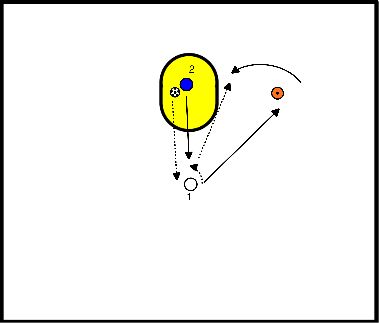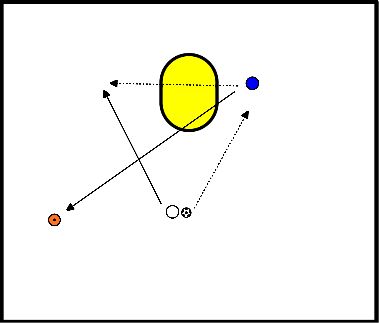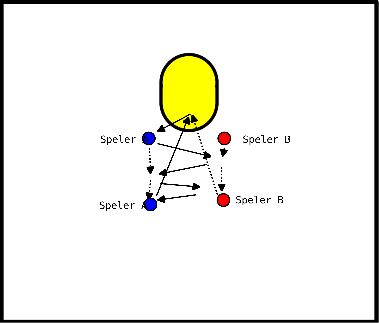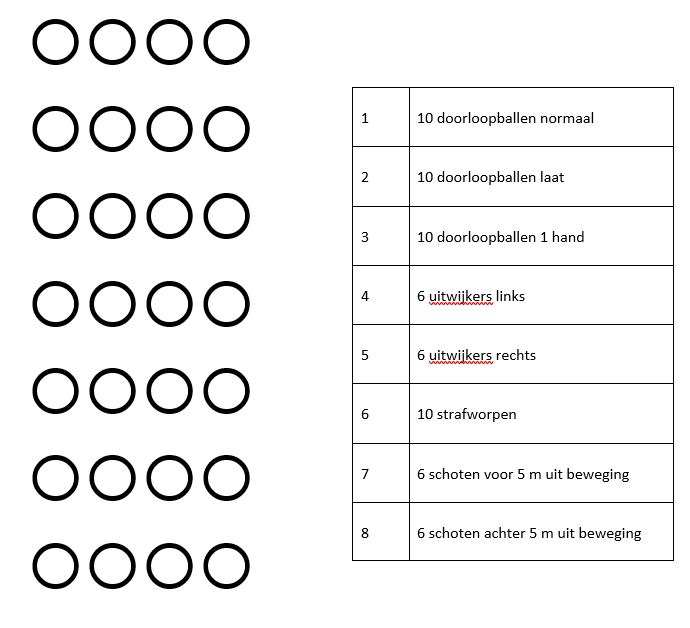Korfball drills
Training on tight passing.
- 2 players start at about 2 metres from each other You can increase/decrease the distance over time or depending on the variation you do.
- Passes must be hard!
- Make sure that you don't throw hard just for the sake of throwing hard, but that you throw hard to get the ball to the team-mate quickly and tightly.
- Keep reminding them of this constantly.
- Passes should also be tight.
- No "piss bows". These passes are slow and easy to intercept.
- When catching with one hand, make sure you move with the hand and if necessary step with the corresponding leg
Variation 1
- Player 1 passes with his right hand to player 2's left hand.
- Player 2 takes over and passes right back to player 1.
- After one minute both players change their throwing and catching hand.
- Repeat this at larger and larger distances.
Variant 2
- Player 1 passes right to player 2's left hand.
- Player 2 passes back with his left hand to the right hand of player 1.
- After one minute both players change their throwing and catching hand.
- Repeat this at larger and larger distances.
Variant 3 - with movement left-right
- Player 1 has the ball.
- Player 2 moves to the left or right.
- Player 1 passes to outside hand of player 2.
- Player 2 passes back with his outside hand.
- After one minute, the players change positions. (Player 1 moves left/right. Player 2 passes to).
- Repeat at increasing distances.
Variant 4 - deep line
- Player 1 has the ball.
- Player 2 moves towards player 1 from the side.
- Player 2 puts his foot across and runs a deep line away from player 1.
- Player 1 passes with a small arc (but still tight!) to player 2.
- After one minute the players change function (player 1 starts running, player 2 passes to him).
- Players run/dribble around a set square. (poles/pawns, sufficient distance from each other).
- Players are given a list of commands in advance, with a corresponding number.
- The trainer calls out a number randomly, players carry out the assignment.
- You can adjust the number of missions and the missions themselves.
- Example of assignments.
- Tapping the ground.
- Jump in the air.
- Sprint to the next pole.
- 1 burpee.
- Backwards as if you are defending until the next pole/pawn.
- Ladder exercise with run through ball
- 1 foot in the ladder, 1 foot next to it, as fast as possible through the ladder and score 15 times
- Sideways through the ladder with two feet in each compartment, 15 x scoring, easy pace
- Start left of the ladder on left leg. Hop on right leg into the ladder and then next to it. Then with left leg into the ladder and next to it, then with right leg again and finish with a through ball. Do this quietly (strengthen ankle joint)
- Ladder exercise without ball
- With two feet in each rung, so small steps as fast as possible(5x per person)
- Skating over the ladder from the left side outside the ladder to the right side outside the ladder.
- 10 short sprints along the ladder with the ball. (as fast as possible)
- Player 1 in front of the basket runs 2 metres out and receives the ball
- Player 2 runs out from under the basket
- Player 1 plays the ball back to player 2
- Player 1 takes the walkthrough ball
- One player for one minute
- Place four hats around the basket at about 3/4 of a meter, one in front, one on the left, one on the right and one behind the basket.
- The shooter starts in front of the basket.
- The receiver stands with the ball under the basket.
- The active player receives the ball and shoots, then walks directly to the next pawn next to the basket. Walk left for 1 minute and shoot on the move at each pawn.
- After one minute, switch from catch to active player.
- Do the same but walk to the right.
Doubles:
- Number 1 in front of the basket (6 meters),
- Number 2 with ball under the basket. 1 pawn left or right of the basket at about 4 to 6 metres.
- Number 2 throws the ball to number 1.
- Number 1 puts the ball on the ground and runs to the pawn and around it towards the basket.
- In the meantime, number 1 runs to the ball on the ground and passes it to number 2 for a deep pass.
- This is repeated until 8 balls have been made.
- The pace is important:
- The runners may not stand still, but you may not run too slowly.
- The timing of the passing must be correct.

Pairs:
- Number 1 with the ball starts in front of the basket.
- Number 2 stands left or right in front of the basket.
- Number 1 throws to number 2 and then pulls away to the side where number 2 is not standing.
- So number 2 is on the left side of the basket, number 1 walks to the right side of the basket.
- Number 2 throws the ball to number 1, after which number 1 shoots.
- Number 1 must catch his own ball.
- During the shot of number 1, number 2 sprints to the pawn, which is on a random spot on the field.
- Place on the pitch depends on the child's level.
- If number 1 hits the ball, he/she gets one point, if number 1 catches the ball before number 2 reaches the cone, number 1 also gets one point.
- so possibility of getting 2 points
- Change function.
- The first to get 6 points wins (variation possible).
- Is the sprinting too easy: add an extra pawn, which increases the sprint distance and for example makes a fast turn.

- Start and finish line, caps are scattered around the field.
- The number of caps is the number of players in the team x 2.
- Caps are brought to the end line one by one, the team that finishes first wins.
- Player A starts with the ball 2.5 meters diagonally in front of the post. Player B also stands 2.5 meters diagonally in front of the post.
- Player A throws the ball to player B and player B throws it back. Thus they bring the ball up to about 8 meters in front of the post.
- From there, player B starts for a through ball from the space indicated by player A.
- However, instead of player B taking the through ball, it now enters the declarer and player A comes in for a clearance ball. Player B catches the ball.
A variation on this:
Only throw the ball when player B runs next to/behind the basket and player B immediately makes a shot. Player A immediately runs in to catch the ball.
Only throw the ball when player B runs next to/behind the basket and player B immediately makes a shot. Player A immediately runs in to catch the ball.
There are more variations on this, such as:
- Most goals in a time frame of, say, 10 minutes
- Who scores 10 goals first
- Make it more difficult by deducting a point for each ball on the ground.
- Possibly with a 3rd player to rotate and keep a slightly slower pace.

- Make a circle at the level of your head on the wall (with sidewalk chalk)
- Make the circle about the same size as a basket.
- Now stand 3 or 4 meters away from the circle.
- Now throw the ball with your left against the wall and catch it with your right hand.
- Do this for one minute.
- The ball must not bounce on the ground.
- If it is too easy, stand further away or try to throw the ball faster. If the exercise is too difficult, try to catch the ball with two hands, but still throw with one hand
- Or stand a little closer to the wall. (Outdoors exercise)

- Who cracks the 4-digit code?
- As soon as they have completed a task, they may enter a number on their code sheet.
- After 4 digits it is indicated how many numbers are in the right place and how many numbers are correct.
- The taker gets played late.
- The defender is right behind him.
- Take it easy. If the defender's back. Looking for the arm...







